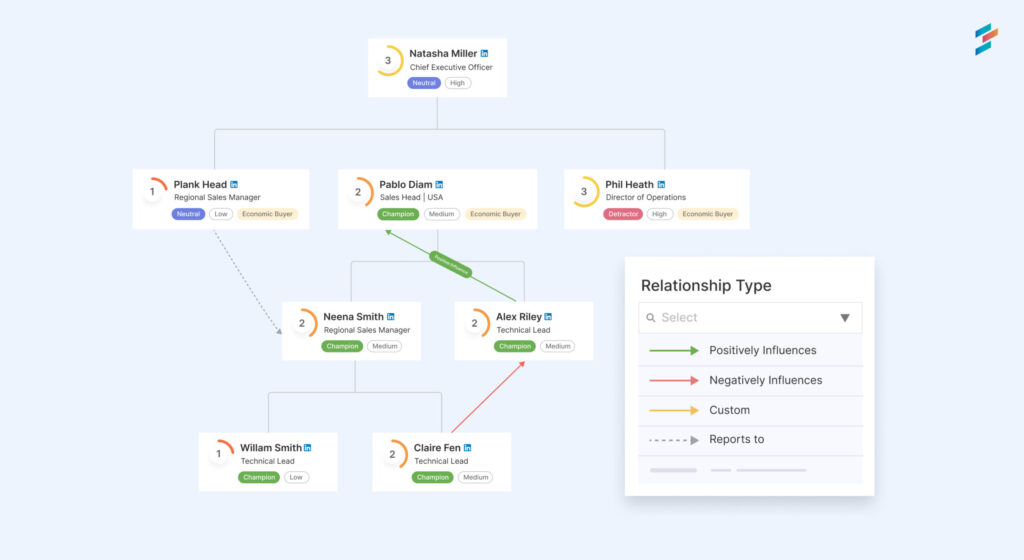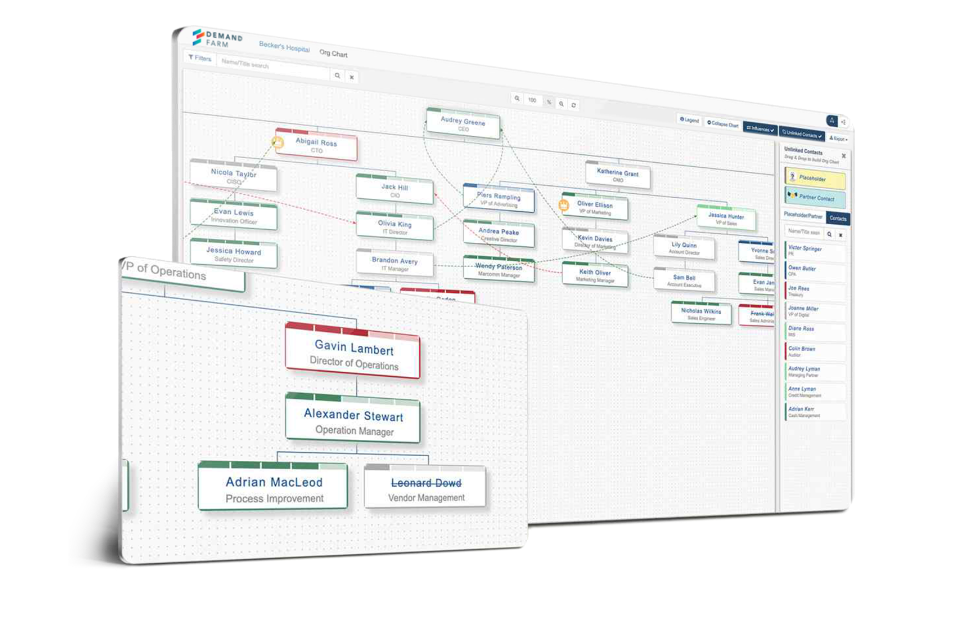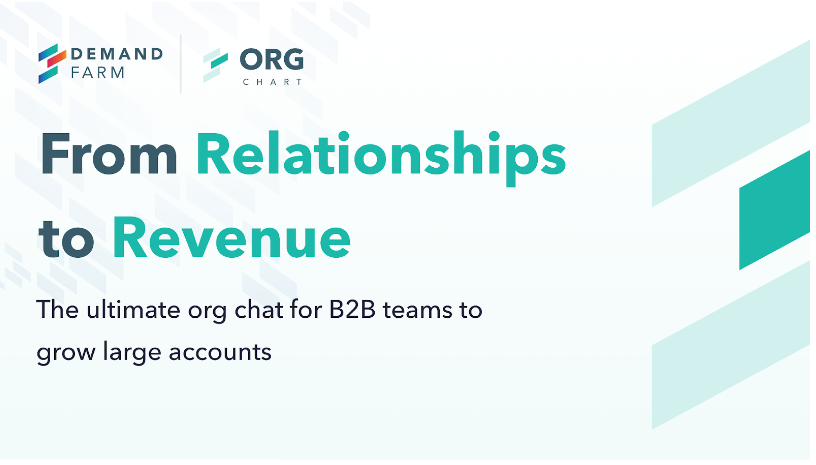Guide to Sales Account Mapping
Account-based marketing (ABM) has been gaining more and more attention in recent times. Many organizations and sales teams see it as the shining new toy that can change their fortunes for good. But the practice is a streamlined approach to existing ad-hoc processes followed in sales – and chances are service provider organizations are already doing some form of account-based marketing even if they don’t realize it. It might not be fully structured or intentional, but the underlying principles can be very similar. When done correctly, accounts-based marketing can allow sales processes to be extremely customized and personalized for different customers. The bespoke approach leads to a better experience for prospective customers, and sales team members of the vendor organization.
The knowledge and skills required to handle different accounts might vary widely, but the underlying theme of account-based marketing – to provide value to customers and extract value for their organization – usually leads to more closed-won deals. Account-based marketing demands a lot of work from sales teams (and the rest of the organization too – but to a smaller extent), and one of the important parts of that work is sales account mapping.
What is account mapping?
The process of representing customer-centric data points and relationship dynamics in a visual way is known as account mapping. Account mapping is used by sales team members to understand how customer organizations work, identify key decision-makers, champions, detractors, and plan their course of action.
It can be seen as a focused version of Org Charts, as it takes informal hierarchies into account and helps team members arrive at the best sales path for that customer. The process focuses on expanding the network and helping sales executives make the most of their foot in the door, even if the leads are only marginally qualified. As a result, a well-constructed account map provides a holistic view of customers and the opportunities that lie ahead. Knowing the preferences of key decision-makers, the issues they’re facing, and the kind of solutions they use can foster professional relationships that lead to long-term business relationships.

Why is account mapping important?
The task of charting external organizations adds details to the enterprise memory of a vendor organization, so that all of the sales team can use the information at any point in the sales cycle. It fills in the data gaps in the customer relationship management (CRM) tool used by sales executives and gives them a head start, especially in case of complex or enterprise accounts. Some more ways in which account mapping can help are listed below.
1. Builds a great first impression
A Statistics from Salesforce shows that 85% of customers are not happy with the way their phone conversations go with sales executives. The overwhelming negativity of the sentiment aside, the reason for it happening is not that the sales teams are not putting in the required efforts but the number of different customers they pursue or manage at any given time. Any sales team worth its salt would want to handle multiple clients successfully, but the reality is that an employee, no matter how gifted and/or dedicated, has only a certain number of hours they can give a customer in a day or week. Field service management software can help maximize these hours by efficiently tracking field workers, ensuring they are where they need to be and that their time is used effectively. Spending this time in finding out more about the customer while handling their requests is not feasible in the long run – and eventually, sales team members just react to the requests instead of proactively finding solutions for newer customers. The pitches get normalized too, with general talking points about product or solution making, presentations are generic and uninspiring. Research dries down to scanning customer websites and going through marketing collateral; 42% of sales executives feel that they call up prospects with less than adequate information about the organization they’re calling and what solutions they might need. An account map at this stage can help the executive immensely to get insights into the prospect organization, the kind of customers it serves, and what are the problems currently ailing them. It provides details about key personnel that can help the sales pitch stand out from run-of-the-mill sales calls, if used properly.
2. Reach the ones with influence & power
Talking to the right person matters in sales, and more so in software solutions – as preferences of different people may vary hugely. The person a sales executive talks to might get convinced – but if that person has to take someone else’s go ahead and fails to convey the advantages – the sale won’t go through. Even in cases where the product doesn’t match the expectations during the pitch, the team can always go back and see if building those into the product/solution is in line with the bigger vision. An account map that is updated regularly provides enough actionable information for sales team members to strategically build rapport with the decision makers in case of new contracts, and develop the business further with existing contacts.
3. Look for fallbacks
Sales teams are at risk with a single organization contact – people quit their jobs in the middle of the deals all the time, and in most cases, the deal gets shelved eventually. The task of rebuilding goodwill falls on the sales team, and they have to start from zero all over again. It’s important to have a wider network so that there are fallback options. Account maps usually have a way around this, as they detail the internal structures with details filled in, so that multiple people can be contacted and kept in the loop at the same time. This is especially helpful in enterprise sales, where multiple stakeholders have to give their go ahead on any purchase of significant size. The additional context provided by the details in the account map leads sales teams closer to closing the account.
4. Appeal to the individual
No matter how professional one might consider themselves to be, personal biases come into play all the time. This has nothing to do with neglecting or ignoring someone, but how the customer representatives understand the message in one format better than others. Some prefer to read at leisure, while some understand better when they’re listening. Personalizing the pitch based on the organization’s needs and specifically pointing to the issue faced by customer executives would definitely help move matters along faster.
5. Aids internal account delivery and the overall sales success
For lead nurturing and account delivery, sales team members have to communicate with other departments internally too – it is not just about talking to customers (and prospects). An account map can efficiently provide the tribal knowledge in the organization about the customer, and sales or key account managers can use it to great benefit. These insights not only reduce the administration load in the future, but can also be used to train new hires or prepare the organization for transition.
Essential components of an account map
An account map is useful because of the data it contains – and the fields can be set to chart the supporters, detractors, the landscape, and many other variables. While vendor organizations can include any detail they deem important in their account maps, some information is usually common.
- Job title does not mean only the name of the position – it shows where the position stands in relation to other members of the customer organization. The role title of the person should contain details about the department, the authority structure, and their level in the organization. Job title, thus, shows how the contact fits in the customer organization structure.
- Visual representation of the organizational relationships clearly shows the organization hierarchy, along with the level of authority that different figures have. This provides a good start in knowing the role of every stakeholder involved.
- Goals, skills and other information, though informal, aid in personalizing the pitch for them. Custom fields in any CRM tool can be used to add them to the account map. Simple charting tools can help too, but using dedicated key account management software can create account maps with much lesser effort.
Account maps are designed to convey the structure of a prospect organization, and including functional and informal relationships present in the customer organization is essential for its effectiveness. The subtleties of interpersonal and interdepartmental relationships at the customer/prospect organization reveal how authority figures exercise their influence, and including it in a visual way, can make understanding customer issues a simple task.
5 key steps for Sales Account Mapping
The sales account mapping process starts in the discovery stage, where sales executives from vendor organizations collate the information they have on the customer together and identify the missing links. The steps involved in this process are:
Step 1: Check if accounts are ideal
Account mapping is not an easy task – finding details of people related to accounts is time consuming. That’s why having an ideal customer persona (ICP) becomes important. While some customers might be willing to spend top dollar, but if all they want their vendors to be is to supply one expertise only, sales teams are better off looking elsewhere. Identifying the ideal key customer means understanding their challenges and finding ways to overcome the obstacles they’re facing. The accounts and prospects that pass the ICP criterion, can be given the attention because the chances of growth are high, as the goals of both organizations follow similar directions.
Step 2: Build a target organizational chart
Mapping begins with plotting the formal organizational hierarchy, and that means either manually entering the data from CRM, or export data in a compatible format and upload it to a chart creation tool. There are plenty of visualization and relationship mapping tools available, and they can be used to create account maps. To streamline the process, a LinkedIn Sales Navigator scraper can automatically gather and organize this valuable information, saving time and ensuring accuracy. Details to be filled in can be found by various means, like LinkedIn, other colleagues, existing info in the vendor organization, and more. LinkedIn Sales Navigator is a good tool that gives plenty of details about executives – including email addresses, contact information, and other placeholder values. For larger organizations (enterprise customers), sales teams must also define the scope and limit the map to a few departments to avoid information overload.
Step 3: Label and sort contacts
Account maps are dynamic – they are never a ‘one and done’ job; sales team members should keep updating it as and when new information emerges. Since all necessary contacts have been listed (and the ways to reach them), the time is right to expand the details – like how they feel about the product, what issues they are dealing with, and so on. Recording all of the above data in the CRM makes it easy to label contacts in customer organizations as ‘deterrents’, ‘supporter’, ‘purchase decision maker’ etc. Account mapping software offers extra features that CRM systems are not designed to handle – like key accounts. They visually depict relationship dynamics in the organization, and make account mapping easier. Org Charts can have colored lines to represent influence, affinity with the contact, purchasing hierarchy, and other relevant fields.

Step 4: Flex sales muscles by being flexible
Sales processes have undergone drastic change, and buying decisions are not made in a hierarchical way either. Democratization of workspace means teams ask for the tools they need, and management involves leaders to decide if the tools are important or not. All this information can be captured in account maps, which show the best sales path and identify executives from customer organizations who can influence decisions, and how to target them effectively.
Step 5: Keep the account map up-to-date
Jobs change, people change, and relationships change too – and therefore, the account map that captures all of these should change accordingly too. There’s no use in trying to approach a client with the data from a 2-year old map (sometimes even as little as a few months old). Sales team members should keep updating contacts, change personnel details as they move on from one organization to another (which gives another opportunity to pitch for a new customer), and expectations of the organization from its strategic partners. Keeping up with the account map leads to the relationship strengthening over time, and the whole process becomes more collaborative. Together, sales, marketing, account management, and delivery teams can contribute to keep the sheet updated on a regular basis, and derive value many times over the effort they put in.
Wrapping things up
An account map, at the end of the day, is just a tool that facilitates decision-making. It’s the data in it that makes all the difference. but tools that interpret and present this data in a snackable format can boost sales practices of any vendor organization. It gives access to the decision-making process of the buyers, and can be used to stay in touch with relevant stakeholders. They also facilitate relationship building with multiple contacts at customer organization, which can come handy when dealing with large enterprises. An up-to-date account map is an asset that exhibits its usefulness in many ways, and helps vendor organizations to tune their pitch perfectly.
 On-Demand Webinar: Unfiltered take on AI in Account Planning: Meet DemandFarm’s KAM AI
On-Demand Webinar: Unfiltered take on AI in Account Planning: Meet DemandFarm’s KAM AI 



